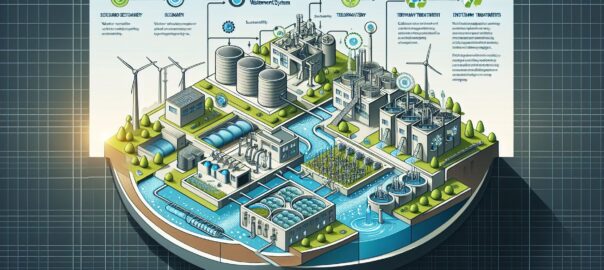Water is the most critical natural resource for all life on earth, yet our current practices are not sustainable. Wastewater management, particularly, poses significant challenges globally. An integrated wastewater treatment system is a step toward a more sustainable and efficient future. In this comprehensive article, we’ll explore what an integrated system entails, its benefits, and how it operates, along with real-world applications and considerations for its implementation.
Understanding Integrated Wastewater Treatment Systems
An integrated wastewater treatment system is a harmonized combination of various processes and technologies designed to treat wastewater effectively before it is released back into the environment or reused. It involves the integration of:
- Physical, chemical, and biological treatment stages
- Wastewater collection systems
- Pumping stations
- Monitoring systems
- Control systems
- Data analytics
The goal is to create a seamless process that not only ensures regulatory compliance but also enhances operational efficiency, cost-effectiveness, and environmental sustainability.
Benefits of Integrated Systems
The key benefits of adopting an integrated approach to wastewater treatment include:
- Enhanced Treatment Performance: Combining treatment processes tailored to specific wastewater characteristics leads to improved removal of pollutants.
- Operational Efficiency: Integration allows for automated control and optimization of treatment processes, resulting in lower labor costs and better resource allocation.
- Cost Savings: More efficient systems use less energy and reduce the need for chemical additives, lowering operational costs.
- Sustainability: By allowing for water reuse and resource recovery (such as energy generation from biogas), integrated systems can significantly reduce the ecological footprint of wastewater treatment.
- Compliance Assurance: An integrated system is better equipped to meet regulatory standards consistently due to improved monitoring and control.
System Components and Integration
An integrated wastewater treatment system is composed of several key components:
- Primary Treatment: Removes solids and organic materials via screening, sedimentation, and sometimes preliminary biological treatment.
- Secondary Treatment: Employs biological processes such as activated sludge or biofilm systems to further break down organic matter.
- Tertiary Treatment: Includes advanced techniques like disinfection, membrane filtration, and nutrient removal necessary for high-quality effluents.
- Sludge Handling: Digestion, dewatering, and disposal or reuse of solids extracted during treatment.
- Advanced Monitoring and Control: Use of sensors, SCADA systems, and real-time data processing to optimize treatment quality and efficiency.
Key Steps in Implementation
- System Design and Engineering: This involves the conceptualization and design of the integrated system based on the composition of the wastewater and final effluent quality requirements.
- Technology Selection: Choosing the right combination of technologies that will be integrated into the treatment system.
- Construction and Commissioning: Building the system according to design specifications and then testing to ensure all components work harmoniously.
- Operation and Maintenance: Includes ongoing adjustments, monitoring, and regular maintenance to ensure the system continues to meet performance standards.
Real-World Applications
Integrated wastewater treatment systems have been successfully implemented in various settings, from municipal to industrial facilities. For instance, the Orange County Groundwater Replenishment System in California, USA, is a stellar example of integrating multiple advanced treatment processes (microfiltration, reverse osmosis, and ultraviolet light with hydrogen peroxide) to produce high-quality water for groundwater recharge and indirect potable reuse.
Another example is the Ulu Pandan Wastewater Treatment Demonstration Plant in Singapore, which showcases the integrated use of technologies such as the membrane bioreactor (MBR) and ultraviolet disinfection to achieve a compact and efficient treatment process suitable for an urban environment.
Careful Planning and Considerations
Implementing an integrated wastewater treatment system requires scrupulous planning and consideration of several factors:
- Local Regulations: Ensuring the design meets all local wastewater treatment standards.
- Financial Investment: Assessing the capital and operational cost implications.
- Stakeholder Engagement: Engaging with the community, regulators, and industry partners to align expectations and gain support.
- Environmental Impact: Considering the ecological effects of construction and operation.
- Future-Proofing: Designing systems that can adapt to regulatory changes, population growth, and technological advancements.
Challenges and Solutions
The road to implementing an integrated wastewater treatment system is paved with challenges, but these can be addressed through careful planning, advanced technologies, and stakeholder engagement. Financial constraints, technological complexity, and operational risks are among the primary hurdles.
To overcome these challenges, municipalities and industries are adopting various strategies such as public-private partnerships (PPPs), phased implementation plans, and investing in workforce training and development to ensure successful system management.
Conclusion
The move toward integrated wastewater treatment systems is an essential step in the progression towards more sustainable water management practices. By combining technologies and processes into a cohesive treatment strategy, we can not only meet today’s environmental and regulatory demands but also prepare for the future. However, each step from planning through to operation requires careful consideration to ensure success.
Sources for Further Reading
- Water Environment Federation (WEF) – www.wef.org/resources/publications/books/
- The Global Water Research Coalition – gwrc.net
- U.S. Environmental Protection Agency – Wastewater Technology Fact Sheet
With the information provided in this article, stakeholders involved in wastewater management are better equipped to understand and navigate the complexities of integrated systems. It is an invitation to innovate, collaborate, and invest in the sustainability and health of our communities and the planet.
